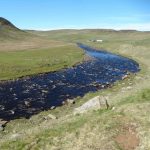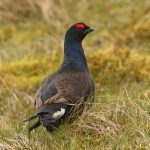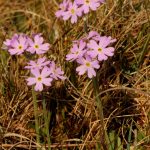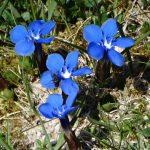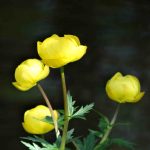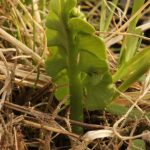On Sunday 13 May, 12 members gathered at the Langdale Beck Hotel in Upper Teesdale for a field trip organised by Ken and Sarah White. The following morning, there was a 6:30 am start to view a nearby Blackcock lek. 19 males were involved, fanning their white tail feathers and holding their wings in an outstretched drooping position. In the background, Curlew, Redshank, Lapwing and Oystercatcher called and Snipe drummed. Higher up the valley, a Golden Plover was seen. After breakfast, there was a short drive to Widdybank Farm on Moor House – Upper Teesdale National Nature Reserve (NNR), where Natural England Senior Reserve Manager Martin Furness was waiting to show the group round Cetry Bank and Widdybank Pasture. Cetry Bank slopes steeply above a bend in the River Tees. Spring Gentian, Bird’s-eye Primrose, Alpine Bartsia, Mountain Everlasting, Bitter-vetch, Common Butterwort and Early-purple Orchid were amongst the sightings here, while down by the river, Common Sandpipers were flying between rocks in the fast flowing water. Up on the acid grassland above Cetry Bank were a different suite of flowers, including Mountain Pansy, Marsh Lousewort and Devil’s-bit Scabious. Martin then led the group round a damp field with Wood Anemones and Globeflowers, where two well camouflaged Snipe chicks were spotted. After thanking Martin, the group continued up the valley, seeing Wheatear and Red Grouse on the way to a picnic spot from which a par of Ring Ouzels were watched. The afternoon destination was Cow Green Reservoir. The nature trail leads past exposures of Sugar Limestone, which was formed when the molten rock intrusions which cooled to form the hard dark Dolerite of the Whin Sill forced their way between layers of Carboniferous Limestone. The layers of Limestone immediately above and below the hot rock baked to a crumbling granular consistency and it is on this rock that the rare assemblage of arctic alpine plants is found, including Spring Gentian, Bird’s-eye Primrose and Spring Sandwort. The walk continued below the dam wall and along the Pennine Way beside Cauldron Snout waterfall. Pitiful bleating came from the other side of the river, where a lamb was trapped just above the water at the bottom of a precipitous slope. We were relieved to hear later that the lamb had been rescued. In the evening, Phill Warren of the Game and Wildlife Conservation Trust gave a talk on Black Grouse and other birds of the area. Intensive predator control by the grouse moor managers has led to one of the highest densities of breeding waders in the country, but raptor numbers are lower than might be expected.
First stop on Tuesday morning was the car park of Bowlees Visitor Centre, where the heads of two baby Mistle Thrushes poked up above the sides of a nest in the fork of a tree. The morning’s walk was along the south bank of the River Tees, between the Low and High Force waterfalls. Two Common Sandpipers and a Grey Wagtail were seen at the pool below Low Force. The footpath ran between the river and a fence which protected the bankside vegetation from grazing. There were wonderful displays of Globeflowers, and other plants included Sweet Cicely, Water Avens, Shrubby Cinquefoil, Early-purple Orchid, Wood Cranesbill and both Shady and Wood Horsetail. Several families of Lapwings were seen in the fields beside the path. The route then led into the NNR, below a Juniper-covered slope. While inspecting Wood-sorrel flowers beneath a Juniper bush, a sharp-eyed member of the group spotted a Herb-Paris plant, which turned out to be a significant local botanical record. The path led to a dramatic viewpoint overlooking High Force, which drops over an outcrop of the Whin Sill. A rare Rock Whitebeam tree was growing on the cliff nearby. Siskins were feeding on the bird feeders back at the Visitor Centre, a Dipper flew under the bridge and large numbers of Common Twayblades were seen. In the afternoon, the group drove over the fells to Stanhope in Weardale. The font in the church is made of the local shining black Frosterley Marble and in the churchyard is a fossil tree from the Carboniferous period. Final stop was a small nature reserve at the spoil heaps of the Whitesyke and Bentyfield lead mining complex. Sightings here included Alpine Penny-cress, Pyrenean Scurvygrass, Spring Sandwort and Thrift. Drifts of Water Avens in the damper parts were a magnet for bumblebees. Ferns included Oak Fern, Brittle Bladder-fern and, after much searching, six tiny plants of Moonwort.
Cronkley Fell was the destination for Wednesday’s walk, starting from Hanging Shaw car park. The walk started out across the valley of the Tees through fields which were yellow with Marsh-marigolds, then continued up through a steep slope of Juniper and out onto the open fells. Red Grouse and Common Heath moths were seen during the climb up through heather moorland. At the top of the ridge were a number of exclosures on exposures of Sugar Limestone. These contained abundant Spring Gentian and Bird’s-eye Primrose, plus Spring Sandwort and a few Mountain Avens plants which were not yet in flower. Cloudberry flowers were found nearby and close inspection of the short turf near the picnic stop revealed about 20 specimens of Moonwort. Some of the party then returned by the same route, getting good views of Golden Plover and Red Grouse on the way. The rest dropped down to the Tees, then followed a rocky path along the river bank, where Stonechat, Wheatear, Common Sandpiper, Oystercatcher, Curlew and Tree Pipit were seen.
Pictures by Ken White and Laurie Haseler

